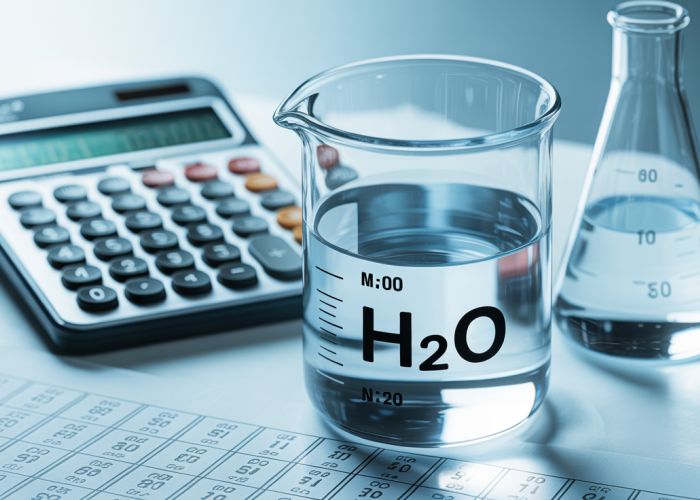Understanding the mass of H2O is fundamental in various scientific disciplines. Consider, for example, the work conducted at the National Institute of Standards and Technology (NIST); their precise measurements are crucial for establishing accurate standards. Analytical Chemistry depends heavily on the accurate determination of the mass of H2O when performing titrations or calculating solution concentrations. Furthermore, consider the implications within the field of Environmental Science where calculations concerning the mass of H2O, are critical for studying climate change and hydrological cycles. Even Avogadro’s constant is fundamentally linked to the molar mass of H2O, providing a bridge between the microscopic and macroscopic worlds. Exploring the concept of the mass of H2O leads to unexpected insights.

Understanding the Mass of H2O: Unveiling the Reality
This article aims to provide a clear and comprehensive understanding of the mass of H2O, commonly known as water. We’ll break down the concept into manageable parts, explaining the underlying principles and offering concrete examples.
Defining the Mass of H2O
The term "mass of H2O" refers to the quantity of matter that makes up a water molecule or a given amount of water. It’s crucial to distinguish mass from weight; mass is an intrinsic property, while weight depends on gravity. We’ll primarily focus on understanding mass in this context.
Atomic Mass Units (AMU) and Grams: The Key Measurements
The mass of a single water molecule is best understood using atomic mass units (AMU). However, for practical purposes, such as measuring water in a lab, grams (g) are a more relevant unit.
- Atomic Mass Unit (AMU): This unit is used to express the mass of atoms and molecules.
- Grams (g): A unit of mass commonly used in chemistry and everyday measurements.
Calculating the Mass of a Single Water Molecule
Understanding how to calculate the mass of a single water molecule is the foundation for understanding the mass of larger quantities of water.
Breaking Down the Water Molecule: H and O
A water molecule (H2O) is composed of two hydrogen (H) atoms and one oxygen (O) atom.
- Hydrogen (H): The atomic mass of hydrogen is approximately 1 AMU. Since there are two hydrogen atoms in a water molecule, their combined mass is 2 AMU.
- Oxygen (O): The atomic mass of oxygen is approximately 16 AMU.
Adding it All Up
To calculate the mass of the entire water molecule, we simply add the masses of its constituent atoms:
2 AMU (from hydrogen) + 16 AMU (from oxygen) = 18 AMU
Therefore, the mass of a single water molecule is approximately 18 AMU.
From AMU to Grams: Introducing the Mole
While AMU is useful for understanding individual molecules, grams are more practical for measuring water in bulk. The concept of the "mole" bridges this gap.
What is a Mole?
A mole is a unit of measurement used to express the amount of a substance. One mole contains Avogadro’s number (approximately 6.022 x 10^23) of particles (atoms, molecules, ions, etc.).
Molar Mass: The Mass of One Mole
The molar mass of a substance is the mass of one mole of that substance, expressed in grams per mole (g/mol). The molar mass of water is numerically equal to the mass of a single water molecule in AMU, but with units of g/mol.
Therefore, the molar mass of water (H2O) is approximately 18 g/mol.
Practical Implications of Molar Mass
This means that 18 grams of water contains approximately 6.022 x 10^23 water molecules. Knowing the molar mass allows us to easily convert between mass and the number of moles, which is crucial in many chemical calculations.
Practical Examples: Determining the Mass of Different Quantities of Water
Let’s look at some practical examples of how to determine the mass of different quantities of water.
Example 1: Calculating the Mass of 2 Moles of Water
If we have 2 moles of water, the mass would be:
2 moles * 18 g/mol = 36 grams
Example 2: Calculating the Moles of Water in 90 Grams
If we have 90 grams of water, the number of moles would be:
90 grams / 18 g/mol = 5 moles
Summarizing Key Values
| Quantity | Value | Unit |
|---|---|---|
| Mass of a single water molecule | 18 | AMU |
| Molar mass of water | 18 | g/mol |
| Avogadro’s Number | 6.022 x 10^23 | molecules/mole |
FAQs About H2O Mass: The Shocking Truth
This FAQ section addresses common questions arising from our article, "H2O Mass: The Shocking Truth Revealed! Must See!". We aim to clarify any lingering confusion about the mass of water molecules (H2O) and related concepts.
What exactly is the mass of a single water molecule (H2O)?
The mass of a single H2O molecule is approximately 18 atomic mass units (amu). Since one atomic mass unit is roughly 1.66 x 10^-27 kg, the mass of h2o is extremely small. This tiny mass is fundamental to water’s properties.
What does "molar mass of H2O" mean, and how is it different?
The molar mass is the mass of one mole of a substance. One mole contains approximately 6.022 x 10^23 molecules (Avogadro’s number). The molar mass of H2O is approximately 18 grams per mole. This represents the mass of h2o in a more practical, measurable quantity.
Why is understanding the mass of H2O important?
Knowing the mass of h2o is crucial for many scientific calculations, including determining concentrations in solutions, understanding chemical reactions, and studying the behavior of water in various environments. Without this knowledge, precise measurements and accurate models would be impossible.
How does the isotopic composition affect the mass of H2O?
While the most common isotopes of hydrogen and oxygen are assumed, heavier isotopes like deuterium (²H) or oxygen-18 (¹⁸O) will slightly increase the mass of h2o. However, these variations are typically minor and considered only in highly precise scientific contexts.
So, what do you think about the mass of H2O now? Pretty wild stuff, huh? Hope you learned something new!